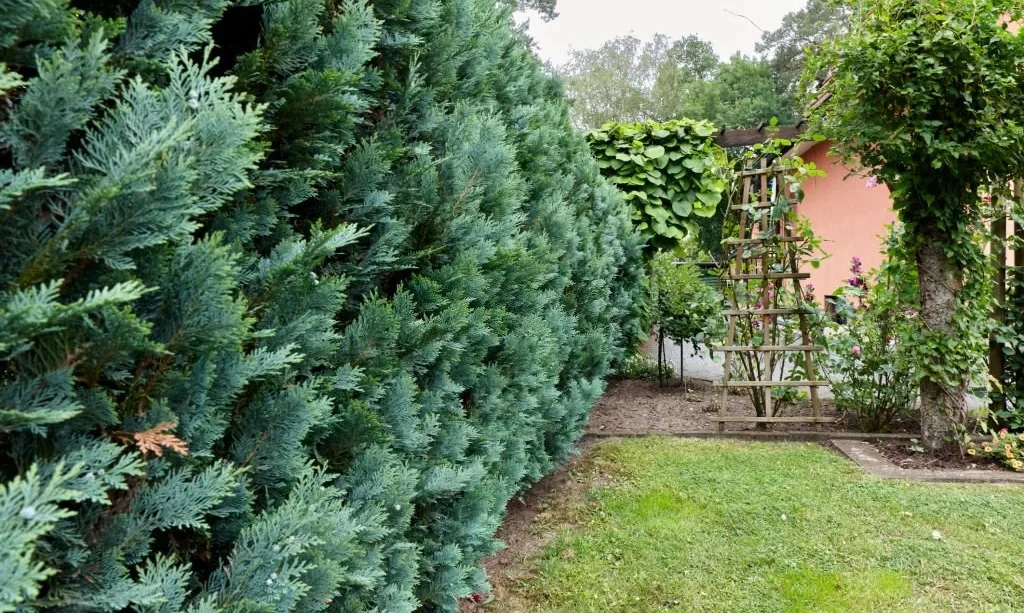Green Giant arborvitae, with their elegant evergreen foliage and rapid growth, have become a favored choice in landscaping and privacy screen plantings. Yet, for gardeners and homeowners who reside in areas inhabited by deer, concerns often arise regarding potential damage to these beloved shrubs. The question that frequently emerges is: Do deer eat Green Giant arborvitae? In this article, we embark on a journey to understand the behavior of deer, their dietary preferences, and the impact they may have on Green Giant arborvitae. By gaining insights into deer behavior, we can better address the challenges of coexisting with these graceful yet sometimes voracious herbivores in our landscapes.
Deer Behavior
Understanding the behavior of deer is crucial when assessing the potential impact on plantings like Green Giant arborvitae. Deer, often regarded as herbivores, have specific feeding habits shaped by factors such as season, region, and the availability of food sources. Here are key aspects of deer behavior related to their feeding habits:
- Seasonal Variation: Deer feeding behavior can vary significantly throughout the year. During the spring and summer, when lush vegetation is abundant, they tend to graze on a wide range of plants, including shrubs and young trees. In the fall and winter, when natural forage becomes scarcer, they may resort to browsing on woody plants like arborvitae.
- Regional Differences: Deer populations and their dietary preferences can vary by region. Areas with high deer populations may experience more significant damage to landscaping plants, including arborvitae.
- Dietary Preferences: Deer have preferences for certain plants over others. They often favor tender shoots, leaves, and buds. However, when food is scarce, they may consume less preferred plants, including arborvitae.
- Adaptability: Deer are adaptable creatures, and their dietary choices can change based on local food availability and pressures from predators.
By delving into the nuances of deer behavior, we can better understand the factors that influence their interactions with Green Giant arborvitae and develop strategies to protect these cherished landscape additions from potential deer damage.
Green Giant Arborvitae: Overview
Before delving into whether deer eat Green Giant arborvitae, let’s first understand these plants. Green Giant arborvitae (Thuja standishii x plicata ‘Green Giant’) are evergreen shrubs known for their impressive size, rapid growth, and attractive foliage. Here’s an overview of these plants:
- Appearance: Green Giant arborvitae typically reach heights of 30 to 40 feet or more, making them one of the largest arborvitae varieties. They have a dense, pyramidal shape with vibrant green, scale-like foliage that retains its color throughout the year.
- Growth Rate: These arborvitae are renowned for their rapid growth, often gaining 3 feet or more in height per year under ideal conditions. This makes them an appealing choice for creating fast-growing privacy screens and windbreaks.
- Landscaping Uses: Green Giant arborvitae are commonly used in landscaping for their ability to provide both privacy and aesthetic appeal. They serve as effective natural barriers, creating living fences and green walls in gardens and properties.
- Compact and Columnar Growth: Emerald Green Arborvitae is known for its narrow, upright growth habit. It forms a dense, columnar shape that makes it an excellent choice for creating privacy screens, hedges, or windbreaks in residential landscapes. Emerald Green only reaches 10-15′ H and 3-4′ W and requires no pruning.
- Vibrant Emerald Green Foliage: As the name suggests, this arborvitae variety features vibrant, emerald green foliage year-round. The foliage consists of small, scale-like leaves that retain their color even in the winter months, providing year-round visual interest.
- Low Maintenance: Emerald Green Arborvitae is relatively low maintenance. It is drought-tolerant once established and requires minimal pruning to maintain its shape. However, regular watering during its initial establishment period is essential for healthy growth.
- USDA Zones: The Emerald Green Arborvitae is a great tree for zones 4-8 where you may be down to -30°F. Plant in full sun to ensure consistently dense foliage and water 2-3 times per week.
- Potted Plant: Ships as a 2.5 gallon potted plant with soil from the Alabama Gulf Coast. This plant is unavailable to ship to Hawaii and Alaska.
Do Deer Eat Green Giant Arborvitae?
The answer to whether deer eat Green Giant arborvitae lies in the nuances of deer behavior and dietary preferences. While Green Giant arborvitae are not considered a top-choice food source for deer, several factors can influence whether deer may browse on these shrubs:
- Deer Pressure: Areas with high deer populations may experience more frequent deer browsing on landscaping plants, including arborvitae.
- Seasonal Variation: Deer are more likely to nibble on woody plants like arborvitae during the fall and winter months when their natural forage becomes scarcer.
- Plant Age: Young Green Giant arborvitae with tender shoots and foliage may be more susceptible to deer browsing than mature, established plants with tougher foliage.
- Local Food Availability: The availability of alternative food sources in the vicinity can also influence deer’s interest in arborvitae. If other preferred plants are readily accessible, they may be less inclined to browse on arborvitae.
- Deterrents: Some gardeners use deer deterrent methods such as fencing, repellent sprays, or companion planting with deer-resistant species to protect their arborvitae from deer damage.
In conclusion, while Green Giant arborvitae are not typically considered a preferred food source for deer, deer behavior and local conditions can influence whether they are at risk of browsing. Gardeners in deer-prone areas should remain vigilant and consider protective measures to ensure the health and longevity of their Green Giant arborvitae.
Strategies for Protecting Green Giant Arborvitae
Protecting Green Giant arborvitae from potential deer damage requires proactive strategies. Here are some effective measures to safeguard these beloved landscape plants:
- Fencing: Install deer-resistant fencing around your arborvitae. This physical barrier can be highly effective in keeping deer at bay. Make sure the fencing is tall enough to deter them from jumping over.
- Repellent Sprays: Apply deer repellent sprays to the foliage of your arborvitae. These products emit odors that are unpleasant to deer and can discourage them from browsing.
- Companion Planting: Surround your arborvitae with plants that are known to be deer-resistant. Deer may be less likely to venture near your arborvitae if they encounter less appealing food sources nearby.
- Motion-Activated Devices: Motion-activated sprinklers or noise-making devices can startle and deter deer when they approach your arborvitae.
- Pruning and Trimming: Regularly prune and trim your arborvitae to remove lower branches and foliage. This not only enhances the aesthetics but can also make it less accessible to deer.
- Tough durable deer netting; Protects landscape and crops from deer and other animals
- Economical, lightweight deer protection; Black UV-resistant deer netting
- Reusable mesh deer fence; Stops deer and other animals from eating shrubs, berries, and vegetables
- Easy to use roll of deer fence netting; Attaches easily to posts and trees
- Do it yourself deer netting for protecting trees, shrubs, orchards and crops
Alternative Landscaping Choices
If deer pressure in your area is exceptionally high, or if you simply want to explore alternative landscaping options, consider these deer-resistant plants and landscaping choices:
- Boxwood (Buxus spp.): Boxwood shrubs are known for their deer resistance and versatility in landscaping.
- Juniper (Juniperus spp.): Junipers come in various sizes and shapes and are often less appealing to deer.
- Barberry (Berberis spp.): Barberry shrubs are thorny and typically not a preferred choice for deer.
- Ornamental Grasses: Many ornamental grasses, such as fountain grass and switchgrass, are deer-resistant and add texture and movement to your landscape.
- Native Plants: Explore native plant species that have evolved to thrive in your region and may be less attractive to deer.
Conclusion
In conclusion, the compatibility of Green Giant arborvitae with deer depends on various factors, including deer behavior, local deer populations, and the availability of alternative food sources. While arborvitae are not their preferred choice, gardeners in deer-prone areas should take precautions to protect these valued landscape plants.
By implementing protective measures like fencing, repellents, and companion planting, you can minimize the risk of deer damage and ensure the health and beauty of your Green Giant arborvitae. Additionally, exploring alternative landscaping choices can provide you with a range of deer-resistant plants to create an aesthetically pleasing and resilient garden.
Ultimately, with careful planning and proactive strategies, you can strike a balance between enjoying the beauty of Green Giant arborvitae and coexisting harmoniously with the deer that share your natural environment.






